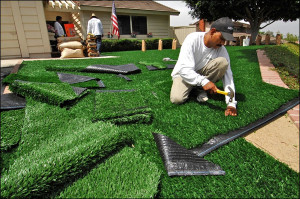In recent times, synthetic turf has moved beyond golf courses and football fields and entered the domain of home landscaping. We’ll demonstrate how this material makes sound sense in various home applications and share lots of other related information.
Applications of Synthetic Turf in Home Landscaping
- Putting greens at home
- Gardens on rooftops that are unable to support traditional lawn weight
- Areas with inhospitable conditions for real grass growing
- Areas that can be easily cleaned for pets
- Where the appearance of grass is desired without the maintenance of real grass
Step-by-Step Synthetic Grass Installation Procedure
Any place where reduction of carbon footprints is desired Synthetic Grass Installation Procedure
- Clear the area of weeds, plant material and existing grass. Opt for a sod cutter in place of a tiller which may affect dormant weed seeds and result in issues later.
- If you’re using nonselective herbicides for clearing existing weeds or lawn, make sure to follow package directions so that you don’t harm nearby plant material.
- Put a 2-4 inch layer of a crushed aggregate like decomposed granite (DG) over the area for positive drainage creation below the synthetic turf. Check that the ground height is appropriate to ensure the turf doesn’t sit higher than its surroundings. Excavate further if necessary. After spreading the aggregate, level it out using a water sod roller.
- You don’t want weeds to spring up through your lawn. Make use of a long period weed barrier above the aggregate base and use landscape staples to secure it. Try to get the best weed barrier fabric because poor quality fabric may not perform sustainably over a period of time.
- Roll out the faux turf onto the area. If you’re using multiple pieces in a large area, make sure the pieces are laid out with blades in the same direction. This will make the end product look polished and professional. Use a box cutter or carpet knife to cut the turf to fit the required area.
- Use 4-6 inches of carpet seaming tape as per package directions or 6-inch landscape staples to put the pieces together. Attach the turf and aggregate base using 6-inch galvanized nails that are placed about 1 inch inwards from the turf edge and at every 4-6 inches on the turf’s perimeter. Begin working with one side first and then tightly pull the turf onto the other side.
- Use a drop spreader to apply some infill material like #30 sandblasting sand. With sandblasting sand, sharp edges are removed and no harmful dust is generated. After the infill material has been spread, use a push broom with soft or medium bristles to work the infill right into the turf, in a direction that’s against the turf grain. Brush evenly to get the infill to move to the base of the fibers.
Benefits of Synthetic Turf
With synthetic turf, you do not require any mowing; watering, or fertilizers. Your water bills are reduced and it looks great all through the year. There are very natural-looking varieties available and without close inspection, it’s almost impossible to know the grass is not real.
Drawbacks of Synthetic Turf
Faux grass is quite high priced and proper skills are required for installation. The cheaper varieties can sometimes look quite unnatural, so it’s always better to install the best quality that’s affordable. In areas with intense sunlight, it might not prove to be a great option because it heats up quickly unless installed in a shady area.
The Home Loan Advisor is a tool that was built to provide homeowners with insight into opportunities available in the current market, without having to shuffle through all of the clutter on the Internet. Not only does the Home Loan Advisor analyze your property, current market conditions, local market comps, and other variables in our proprietary algorithm, but we match you with potential lenders who have products that may help you and provide you with a sense of stability.
Smart homeowners should know the value of your home. You can get a free home valuation report from Neighborhood IQ to find out your home’s worth to help you decide if you should refinance now.

